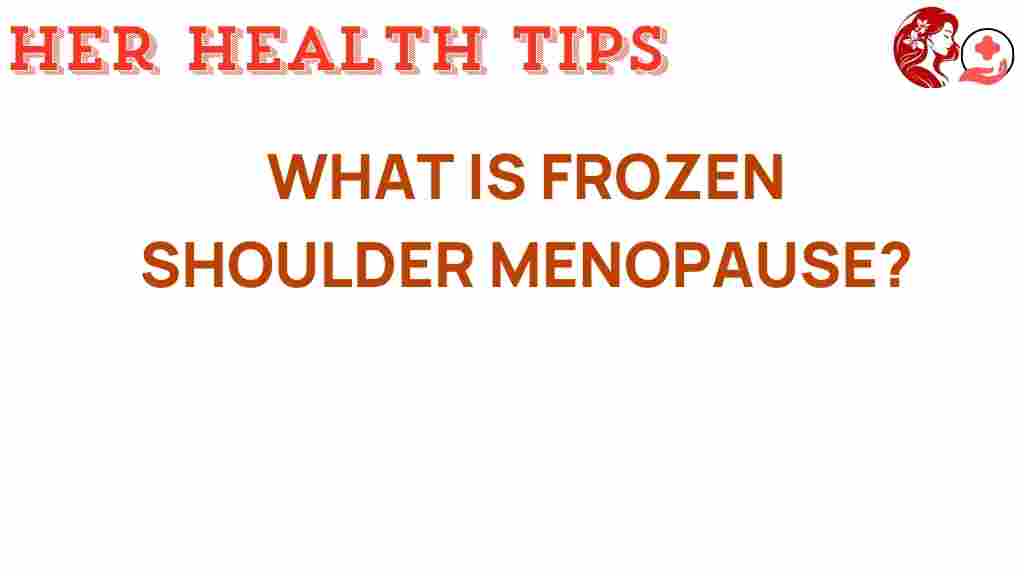Unveiling the Mystery of Frozen Shoulder Menopause
Frozen shoulder, also known as adhesive capsulitis, is a condition that can significantly impact mobility and cause joint pain, particularly affecting women during menopause. As hormonal changes occur in a woman’s body during this time, the risk of developing frozen shoulder can increase. Understanding the symptoms, treatment options, and recovery processes is essential for managing this condition effectively. This article delves into the intricacies of frozen shoulder during menopause, its symptoms, treatments, and strategies for recovery.
Understanding Frozen Shoulder
Frozen shoulder is characterized by stiffness and pain in the shoulder joint. It typically develops gradually and can significantly impair mobility. The condition often goes through three phases:
- Freezing Phase: This initial phase can last from 6 weeks to 9 months, with increasing pain and stiffness.
- Frozen Phase: During this phase, the pain may begin to lessen, but the stiffness remains, making movement difficult. This phase can last from 4 to 6 months.
- Thawing Phase: The final phase where mobility gradually improves, which can take 6 months to 2 years.
The Connection Between Menopause and Frozen Shoulder
Menopause brings about significant hormonal changes, particularly a decrease in estrogen levels. This hormonal shift can affect the connective tissues in the body, making them more susceptible to inflammation and stiffness. Research suggests that women undergoing menopause are at a higher risk of developing frozen shoulder due to these factors:
- Hormonal Fluctuations: Lower estrogen levels can lead to changes in collagen and connective tissue, contributing to joint pain.
- Age Factor: Menopause typically occurs in women between 45 and 55 years old, coinciding with a natural decline in joint health.
- Inactivity: Many women experience reduced activity levels during menopause, which can lead to stiffness and frozen shoulder.
Symptoms of Frozen Shoulder During Menopause
The symptoms of frozen shoulder can vary in intensity but typically include:
- Persistent Pain: A constant ache in the shoulder, which may radiate down the arm.
- Stiffness: Difficulty in moving the shoulder, particularly when reaching overhead or behind the back.
- Limited Range of Motion: Noticeable reduction in the ability to perform everyday tasks.
- Night Pain: Increased discomfort during the night, often disrupting sleep.
If you experience these symptoms, it’s crucial to consult with a healthcare professional for an accurate diagnosis and treatment plan.
Diagnosis of Frozen Shoulder
A healthcare provider will typically conduct a physical examination and may request imaging tests, such as:
- X-rays: To rule out other conditions like arthritis.
- MRI: To assess the soft tissues around the shoulder joint.
Treatment Options for Frozen Shoulder
Managing frozen shoulder often requires a combination of treatments. Here are some common options:
1. Physical Therapy
Physical therapy is the cornerstone of treatment for frozen shoulder. A physical therapist can develop a tailored exercise program to:
- Improve range of motion
- Strengthen shoulder muscles
- Reduce pain and inflammation
2. Medications
Over-the-counter pain relievers such as ibuprofen or acetaminophen can help manage joint pain. In some cases, a doctor may recommend:
- Corticosteroids: Injected directly into the shoulder joint to reduce inflammation.
- Topical Analgesics: Creams or patches applied to the skin can provide localized relief.
3. Heat and Cold Therapy
Applying heat or cold to the shoulder can help alleviate pain and stiffness. Heat therapy can relax and loosen tissues, while cold therapy can reduce inflammation.
4. Alternative Therapies
Some women find relief through alternative therapies such as:
- Acupuncture: May help reduce pain and improve mobility.
- Massage Therapy: Can relieve tension and enhance blood flow to the area.
5. Surgical Options
If conservative treatments fail, surgical options such as manipulation under anesthesia or arthroscopic surgery may be considered to release the tight shoulder capsule.
Recovering from Frozen Shoulder
Recovery from frozen shoulder can take time, but with proper treatment, most women can regain their shoulder function. Here are some steps to aid recovery:
- Stay Active: Engage in gentle exercises as prescribed by your therapist.
- Consistency: Regularly perform stretching exercises to maintain flexibility.
- Listen to Your Body: Avoid pushing through intense pain, as this can exacerbate the condition.
- Maintain a Healthy Diet: Focus on anti-inflammatory foods to support joint health.
Troubleshooting Tips for Managing Frozen Shoulder
If you’re struggling with frozen shoulder during menopause, consider these tips to ease your journey:
- Keep a Pain Journal: Document your pain levels and activities to identify triggers.
- Practice Relaxation Techniques: Stress can exacerbate pain; try yoga or meditation.
- Seek Support: Join a support group for women experiencing similar issues to share experiences and advice.
Conclusion
Frozen shoulder is a challenging condition that can significantly affect women during menopause. Understanding the link between frozen shoulder, menopause, and joint pain is crucial for effective management. By recognizing the symptoms, exploring treatment options, and committing to a recovery plan, women can regain their mobility and improve their quality of life. Remember, early intervention is key, so don’t hesitate to consult with healthcare professionals about any concerns regarding your shoulder health.
For further reading on women’s health and joint pain management, check out this comprehensive guide. Additionally, you can explore more about frozen shoulder treatment options through this external resource.
This article is in the category Conditions and created by HerHealthTips Team
